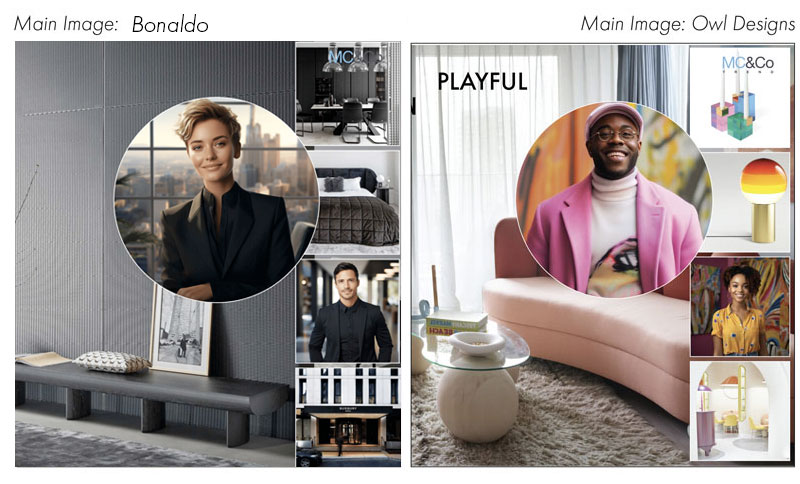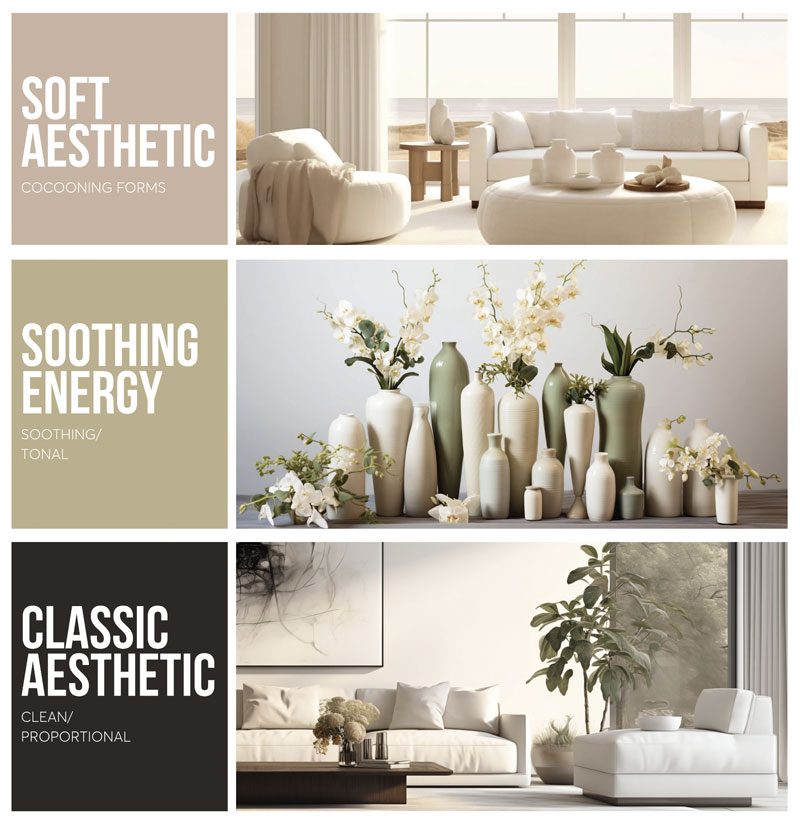INTERVIEW WITH MICHAEL CLEGHORN, MC&Co TREND
Here is a close look at the six shopper aspirations that MC&Co Trend says
will define how consumers will make furniture purchase decisions in 2024.
For this Design and Designer series installment, Furniture World interviewed
Michael Cleghorn, Founder & CEO of MC&Co Trend, a company that, according to
the company website (mccotrend.com), presents “powerful, unbiased trend
forecasting reports to change the way you predict, develop and design,
without guesswork or bias.”
Cleghorn noted that what differentiates MC&Co Trend is that he and his
co-founder, Linda Simpson, CEO of Imagination Network, their US and North
American partner, both came to the company from commercial backgrounds.
“Linda,” he said, “had diverse experience as a buyer and product development
manager with companies such as Bloomingdale’s, Associated Merchandising,
Silvestri and Enesco. I was a buyer, merchandiser, and brand manager for
large Australian retailers. We met while working on a project with the
Department of Trade in the Philippines tasked with repositioning the
Philippines as a credible source for homewares and furniture. It was then
that we realized there was an opportunity to create a forecasting process
that was commercially focused and actionable.
“Some trend reports we saw in the marketplace at the time had such a broad
focus that it seemed like everything was trending. We wanted to bring our
reporting into focus for manufacturing and retail brands. This idea drove us
to develop a scalable process we call our Trend Intelligence System.
“Our forecasts look at about 40,000 images from the world’s most important
retail and wholesale brands, interior designers, hotels, and magazines. We
use this information to create 26 different positions on style every six
months. We also track 26 moods and put them through a series of useful
filters.”
Cleghorn said their forecasting process starts with a focus on six
‘aspirations’ that align with the ‘moods’ in the marketplace —grounded,
ordered, escape, nostalgic, playful and opulent. “Although they are always
present in the home furnishings market,” he observed, “these aspirations
evolve due to geopolitical, demographic, social, economic and other
conditions.
“The second thing we look at is how home furnishings consumers view their
lives through the five attributes of mood, color, pattern, material and
texture, and shape. There are four different ways that people approach their
lives through these five attributes: optimism, ambition, discipline, and
accomplishment. “Thirdly, our analysis addresses the evolution of the styles
we follow regarding their commercial timing and positioning. For example,
what’s happening with coastal, mid-century or traditional elements.”
Although MC&Co Trend’s analysis looks at trend forecasting from a macro
perspective, its primary focus is creating information that can be highly
customized for manufacturing brands and retailers. To take advantage of the
full range of information available, brands and retail organizations must,
as a first step, have awareness of the evolving aspirations of their target
customers. That’s something many furniture retailers haven’t fully grappled
with.
Pragmatic vs. Decorated Homes
“I think it’s essential, Cleghorn said, “that retailers and brands start
looking more closely at their customers’ aspirations. Much of the market is
moving away from offering products that are highly focused on serving
pragmatic sorts of customers, for example, by showing the best-priced
three-piece recliner set in leather and building a room package around it.

“Their forecasting process starts with a focus on six ‘aspirations’ that
align with the ‘moods’ in the marketplace—grounded, ordered, escape,
nostalgic, playful and opulent.”
“The consumer focus on expressing personality through furnishing homes is a
growing trend, driven in part by ‘reveal shows’ that change rooms from
cluttered messes to fabulous environments. Studio McGee’s mission to ‘Make
Life Beautiful’ and similar shows have built awareness that there is
spiritual or emotional significance to home environments that can make
people feel better.
“Many retailers have been looking at each other and trying to price
competitively rather than taking a broader view of their customer’s
lifestyles. Retailers like Williams Sonoma have grown by taking on lifestyle
positions. Big box companies like Lowe’s and Target, have developed a real
focus on trends that surpasses what many traditional furniture retailers
have done.”
Six Aspirations Defined
-
Ground Aspiration: “The ground aspiration is the
emotional connection to creating calming, relaxing havens that make
customers feel earthy, spiritual and healthy. It has grown in influence
over the last ten years, along with yoga, mindfulness, farmer’s markets
and slow living. The ground aspiration is internally focused on ‘me, my
health and self.’ From a macro perspective, the ground aspiration is
stable and has influenced the following five aspirations.”
-
Escape Aspiration: “The escape aspiration is about
being extroverted, engaging with people, having good times, entertaining
and, sometimes, bringing vacations into home environments. We see the
nostalgic aspiration, a sentimental idea, growing and diversifying in
the current geopolitical environment.“
-
Nostalgic Aspiration: “Our customers have experienced a
pandemic, a cost-of-living crisis, inflation, uncertain geopolitical
situations and wars popping up everywhere. They feel nostalgic for what
seems like safer times. The nostalgic aspiration is growing and
diversifying from a macro perspective.”
-
Opulent Aspiration: “Opulent is an aspiration connected
to being seen as wealthy and living a luxurious, sophisticated, worldly
existence. It is also increasing in influence. From a fashion
perspective, labels have moved from the outside to the inside of
garments because overt displays of wealth during tough times can be seen
as vulgar. Soccer moms have transitioned from driving a Mercedes Sport
to a Mercedes SUV. They still buy luxury but frame their purchases from
a different set of needs, such as the safety of their kids. Instead of
saying they are going to a glamorous resort, they may describe it as a
six-senses yoga retreat.
“People want to achieve old-money looks as opposed to new-money looks.
Louis Vuitton, Chanel and other well-known apparel companies tend to be
seen as crass, new-money brands. Instead, consumers are reconsidering
Brooks Brothers and classic Ralph Lauren aesthetics.”
-
Ordered Aspiration: “The ordered aspiration is all
about seeking comfort in order. This aspiration is currently stable and
influential.”
-
Playful Aspiration: “Playful, characterized by whimsy
and color, is all about being spirited, cheerful and rebellious. We’re
talking Jonathan Adler-type styles, boosted by an exit from COVID with a
need for optimism.”
“Pottery Barn focuses on traditional American nostalgia. West Elm focuses on
mid-century nostalgia. Crate & Barrel has an ordered and grounded
aspiration, and Jonathan Adler has a highly playful aspiration.”
Gobblers and Nibblers
“I don’t mean this in a derogatory way,” Cleghorn noted, “but retail market
share is being siphoned off from many old-style furniture companies. The
market is changing. Look at what fast retail fashion brand Zara
(https://www.zara.com) did in clothing and home furnishings, then consider
why department stores have lost so much market share over the past 20
years.”
Cleghorn elaborated on why furniture retailers should be alert for what he
calls gobblers and nibblers. “Many emerging digital home furnishings brands
that focus on a single aspiration,” he observed, “have gobbled up market
share from more traditional brick-and-mortar furniture store brands that
appeal to a wide audience.”
He is uncertain whether many of Furniture World’s readers have focused
enough on identifying these single aspiration competitors or created
effective strategies to compete against them. “For example,” he said,
“Pottery Barn focuses on traditional American nostalgia. West Elm focuses on
mid-century nostalgia. Crate & Barrel has an ordered and grounded
aspiration, and Jonathan Adler has a highly playful aspiration. For high-end
stores, maybe RH is gobbling up market share, and for a promotional store,
perhaps it’s Target.
“Besides gobblers, furniture retailers must be aware of smaller online
nibblers selling particular looks that focus on a specific aspiration
through Wayfair and Amazon. Only then can they develop ways to take back
little bits of market share from these guys.”

Grounded Aspiration
CALM EMOTIONAL CONNECTION
- I aspire to be earthy, spiritual and healthy
- I have an independent mind
- I seek meaning and connection
- I focus on authenticity
- I value artisanal methods
- Trend Movement: Stable & Influential
Escape Aspiration
FREEDOM EMOTIONAL CONNECTION
- I aspire to be relaxed and friendly
- I am collaborative and welcoming
- I seek comfort in good times
- I love traveling and I value the outdoors
- Trend Movement: Stable & More Romantic
Managing Style Evolution
Furniture World asked Cleghorn how furniture retailers might evolve from
selling a sea of products to being more trend-focused.
“My advice is to give customers what they want at the moment, then inspire
them with what they could have,” he replied. “They should do more research.
For example, match our six aspirations with their customer’s transactional
histories. And incentivize customers to fill out customer surveys that place
them in the most stable aspirational groups, such as grounded or ordered.
“Large retailers can afford to have marketing departments that talk about
their customers’ feelings, avatars, profiles or personas in a sophisticated
way backed by research, but any retailer can put a variety of looks and
styles in their social media feeds and measure engagement. They can also
look at their top sellers, see where they align with the six aspirations,
and review helpful, free materials found online, including previous
forecasts on the mccotrend.com website.

Opulent Aspiration
LUXE LIFE EMOTIONAL CONNECTION
- I desire luxury
- I adore expressions of glamour
- I am sophisticated and worldly
- I seek comfort in luxury
- I see value in the cosmetic
- Trend Movement: Increasing + Pared Back
Nostalgic Aspiration
SENTIMENTAL EMOTIONAL CONNECTION
- I aspire to celebrate history
- I seek comfort in the past
- I am retrospectively focused
- I see value in revisiting
- Trend Movement: Growing + Diversifying
“The goal of performing this kind of research can be to present products and
collections better aligned within the evolving part of their market, moving
selections slowly towards positions that reflect how their customers’
aesthetics are evolving.
“Doing this requires an alignment of proportion, material and texture for
case goods and upholstered designs. We suggest creating more stories that
resonate with customer aspirations. Develop small in-store presentations
that reflect where these aspirations are going and maybe do softer marketing
around concepts to see how customers respond. That’s how to pull new
customers away from gobblers and nibblers. We talk to our clients about this
based on the deeper work we do, but there’s no reason why other retailers
can’t start thinking about these issues on their own.”
Cleghorn observed that brands and retailers tend to blame poor sales
performance on the products they produce or purchase from suppliers. “They
approach us saying, ‘We’ve got a product problem.’ Our analysis shows that
they often have problems knowing who their customers are, how their internal
teams communicate, or their processes.
“Retail departments can be quite siloed. Buyers and product developers may
buy a product with a certain concept in mind. But then, their visual
marketing and advertising departments develop different concepts completely
out of sync with the original intention.
“All departments should be on the same page regarding their target
customers’ aspirations, approach to life, cycle, viability and velocity.
Once this language enters a business,” he emphasized, “buyers or product
developers can explain if a concept they create is emerging or evolving for
their audience. Then, marketing departments can adjust messaging to, for
example, attract the interest of early adopters or adjust to a mainstream
mood.
“An awareness of customer aspirations,” he continued, “can become part of a
company’s brand DNA. When that happens, a new language forms that seamlessly
links product development to marketing and retail operations. Once everyone
in an organization understands this language, it leads to better planning,
execution and emotional connections with customers.
“This approach is also a great way to bring analysts and senior managers who
may not have a strong understanding of where aesthetics and style are going,
into the conversation so they can manage the people below them.”

Ordered Aspiration
STRUCTURED EMOTIONAL CONNECTION
- I aspire to be structured and strategic
- I seek comfort in order
- I adore functional design
- I value classicism
- Trend Movement: Stable + Influential
Playful Aspiration
SPIRITED EMOTIONAL CONNECTION
- I aspire to be cheerful
- I am rebellious and noticed
- I seek comfort in whimsy and humor
- I am color focused
- I see value in lightheartedness
- Trend Movement: Growing + Challenging
Baby Steps
Engaging with this process doesn’t often happen in one season. “That’s why
many of our clients,” said Cleghorn, “are on a two- or three-year program of
evolution starting with what we call a ‘handhold to handover.’ Check-ins are
needed to measure the implementation progress. It’s necessary to ask if the
rug buyer is aligned with the lighting buyer, the upholstery buyer and the
case goods buyer. Is everyone from the CEO to the newly hired sales
associate aligning their stories?”
Market Movement
He explained that marketing to shoppers with a focus on the grounded,
ordered, escape, nostalgic, playful and opulent aspirations is a proven way
to attract customers interested in expressing themselves through home
interiors. Purely transactional shoppers who primarily want a comfortable
and affordable sofa may not be as interested in digging deeper.
“In general, the market for home furnishings is moving towards shoppers who
are thinking, ‘What do these products say about me? What will people think
of me? Do I feel the emotional connection?’ Marketing with this in mind has
become a more important consideration.”
Losing Entrepreneurial Assessment
Cleghorn believes that some retailers who buy by the numbers can lose the
art of what he calls entrepreneurial assessment. “If we think about the
market in a very simplistic way,” he explained, “there are three types of
shoppers: the decorator, the innovator and the pragmatist. The market is
moving from the pragmatist type to the decorator type. So, retailers
operating by the numbers in functionally oriented furniture operations
should, depending on their specific model, consider moving from a pragmatist
toward a decorator orientation.
“In a design business, not everything can be run by spreadsheets. There has
to be a dynamic tension between analytics and entrepreneurial assessment,
vision and risk-taking,” he observed. “There’s a lot less risk in retail
than we used to have. Innovating and taking on risks needs to be qualified.
This is what we try to do through our trend forecasts. We qualify where the
least risk is for a business looking at innovation through product programs.
Every company must find a path forward by evolving a measurable strategy
that works within the current supply chain and marketing dynamics.
Refreshing an evolving style is usually less risky than working with
emerging trends. However, retailers can take elements from emerging trends
and apply them to evolving trends to stay relevant.”

Macro Trends
Macro trends are considered high-level forecasts that provide a
framework for a wide variety of interpretations. A macro trend can be
applied to any of the six aspirations—grounded, ordered, escape,
nostalgic, playful and opulent.
The most recent MC&CO Trend forecast has identified macro trends,
including increased consumer alignment to romantic, layered
aesthetics, bold, strong shapes and vibrant color energies.
Demographic Effects
Retailers can no longer assume that older shoppers will necessarily aspire
to create traditional home environments and that younger demographic groups
will do the opposite. Cleghorn provided an example. “Interior designer,
actress and fashion designer Iris Apfel,” he pointed out, “has created a new
culture of older women who are saying that they refuse to age gracefully.
Instead, they want to be incredibly playful through color, whimsy and humor.
That’s a ‘playful aspiration’ mindset normally associated with a younger
generation.”
He believes that shopper’s aspirations and approaches to life have little to
do with age, earnings or socioeconomic position. “People who want opulence
in their lives,” he told Furniture World, “can be wealthy, retired baby
boomers who hire top designers to create million-dollar fit-outs for their
apartments. But a 26-year-old Gen Xer who lives in a basic studio apartment
might fulfill their opulent aspiration by purchasing a velvet cushion from
K-Mart or Target.”
Conclusion
In closing, here are other style considerations retailers might think about
courtesy of Michael Cleghorn:

More Macro Trends
There are many style trends in the current marketplace. Although
vibrant energy, romantic layering, and strong attitudes are
increasing, there are also high levels of consumer alignment to
classic, simple aesthetics, soft, curvilinear shapes, and soothing
tonal color energy.
-
Polarization: What’s interesting about our six
aspirations from a marketing perspective is that home furnishings
shoppers’ social media feeds have become polarized. If a shopper keeps
searching online for nostalgic home furnishings styles, eventually,
that’s all they will be exposed to. Much like politics, style is
becoming more polarized.
-
Style Guides: If you don’t already have one, create a
style guide.
-
Alignment: Create alignment between buyer categories.
-
Be Alert: Watch retailers that present highly
considered, curated and resolved interior expressions, such as RH, West
Elm and Room & Board. They’re growing.
-
Self-curation: If your store targets customers with
multiple aspirations and lifestyle choices, consider focusing on
eclectic self-curation. Consumers who want to tell you ‘their style’ is
a strongly growing innovator category.
-
Individualism: Consider that younger consumers mix
their clothing eclectically to create their own styles. Many, especially
those with less disposable income, are focused on mixing, re-purposing
and recycling flea market and secondhand shop finds with contemporary to
build highly eclectic, self-curated interior home furnishings looks.
This trend is likely to influence more mature demographics as well.
-
Small nibblers: Highly curated looks that reflect a
specific mood may be difficult for some established furniture retailers
to commercialize. Consider how small online nibbler companies that have
done this successfully are siphoning off market share.